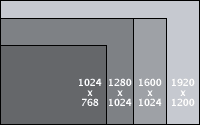 Varicam
runs at 1280 by 720 (16 x 9 not on illustration) and panasonic pro hd and sony hd run at 1920 by
1080 - though Sony HD is actually 1440 x 1080 interpolated up to 1920 x
1080.
Varicam
runs at 1280 by 720 (16 x 9 not on illustration) and panasonic pro hd and sony hd run at 1920 by
1080 - though Sony HD is actually 1440 x 1080 interpolated up to 1920 x
1080.
-
- The New HDV format is also 1440 x 1080
but is recorded in Mpeg format which introduces many motion artefacts.
-
- The point of this is to show that all
standards in digital video are now measured in pixels - 1080 lines, or
720 lines means the line height is the same as pixel height - in other
words the vertical resolution of the picture. I've seen both 1080 and 720
projected and 720 can look absolutely fine (actually I've seen the screening
of a pal originated short on a very fine projector sand this was line free
!). I've also transferred Sony 1080, Panasonic 720 and Pal digibeta uprezzed
to HD onto 35mm - the digibeta looks surprisingly good in comparison as
it has a greater colour depth overall than either format in comparison.
-
- The colour rendition of the panasonic
varicam is better than the Sony regardless of pixel ratio. The 4:2:2 reference
is black and white followed by colour bit depth, Sony HD is 3:1:1 and the
panasonic HD Camera is 4:2:2, Panasonic Varicam is 2:1:1. The Viper fimstream
and Sony SR recording (ONLY you use an american 950) are 4:4:4.
-
- Even with all the above you have to work
to make this stuff look like film. If you do obvious video things - then
it'll look video. You have to be careful around windows as video burn outs
look awful in relation to the way film handles it.
-
- Go to this address for a quick answer
to your question about the use of STANDARD
DEFINITION LENSES USED WITH HIGH DEFINITION CAMERAS With thanks to Mike Brennan DoP for this information.
-
- BACK
-
- Please e-mail me if you understand this
differently - I want to learn ! If you squeeze some putty it comes through
your fingers - if you get good colour you lose resolution or speed etc
etc....
 Varicam
runs at 1280 by 720 (16 x 9 not on illustration) and panasonic pro hd and sony hd run at 1920 by
1080 - though Sony HD is actually 1440 x 1080 interpolated up to 1920 x
1080.
Varicam
runs at 1280 by 720 (16 x 9 not on illustration) and panasonic pro hd and sony hd run at 1920 by
1080 - though Sony HD is actually 1440 x 1080 interpolated up to 1920 x
1080.
 Varicam
runs at 1280 by 720 (16 x 9 not on illustration) and panasonic pro hd and sony hd run at 1920 by
1080 - though Sony HD is actually 1440 x 1080 interpolated up to 1920 x
1080.
Varicam
runs at 1280 by 720 (16 x 9 not on illustration) and panasonic pro hd and sony hd run at 1920 by
1080 - though Sony HD is actually 1440 x 1080 interpolated up to 1920 x
1080.